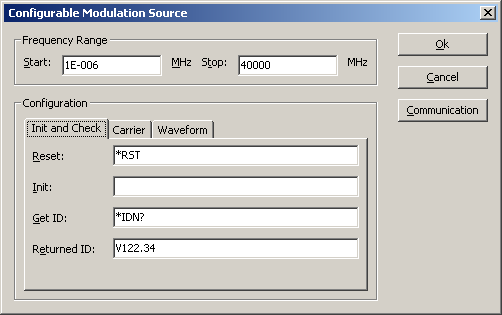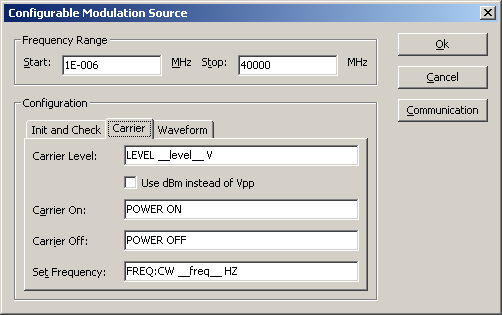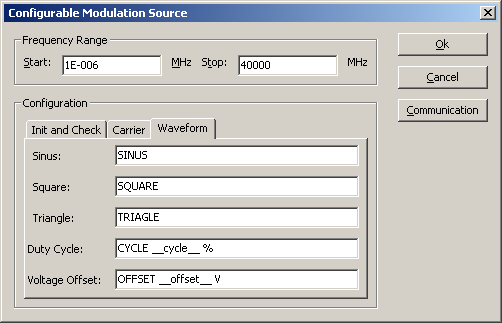Configurable Modulation Source: Difference between revisions
Jump to navigation
Jump to search
No edit summary |
No edit summary |
||
| Line 22: | Line 22: | ||
{{ScreenElementDescription|Square|The command that is send to the device to set the signal type to square.}} | {{ScreenElementDescription|Square|The command that is send to the device to set the signal type to square.}} | ||
{{ScreenElementDescription|Triangle|The command that is send to the device to set the signal type to triangle.}} | {{ScreenElementDescription|Triangle|The command that is send to the device to set the signal type to triangle.}} | ||
{{ScreenElementDescription|Duty Cycle|The command that is send to the device to set the duty cycle. Because the command can contain more then just the value that needs to be send, a indicator is used. The indicator for the level is the code '''__cycle__'''. | |||
Example: CYCLE '''__cycle__''' %. and the duty cycle that needs to be send is 50%. | |||
Will result in LEVEL 50 %}} | |||
Revision as of 14:31, 21 August 2009
| Command to be send to the device to reset the device. Leave blank if you do not want to reset the device. |
| Command to be send to the device to initialize the device. Leave blank if you do not want to initialize the device. |
| Command to be send to the device to get the identification from the device. Leave blank if you do not want to verify if the device is connected. If you do not use the verify, RadiMation® will not raise an error when a device is not connected during the initialization of a test. |
| The complete or a part of the return string from the device. The string is compared and when found the check will return that the device is connected. |
| The command that is send to the device to set the level. Because the command can contain more then just the value that needs to be send, a indicator is used. The indicator for the level is the code __carrier__.
Example: LEVEL __carrier__ V. and the level that needs to be send is 2 V. Will result in LEVEL 2 V |
| The command that is send to turn on the carrier of the modulator. |
| The command that is send to turn off the carrier of the modulator. |
| The command that is send to the device to set the frequency. Because the command can contain more then just the value that needs to be send, a indicator is used. The indicator for the level is the code __freq__.
Example: FREQ:CW __freq__ HZ. and the frequency that needs to be send is 200 Hz. Will result in FREQ:CW 200 HZ. |
| The command that is send to the device to set the signal type to sinus. |
| The command that is send to the device to set the signal type to square. |
| The command that is send to the device to set the signal type to triangle. |
| The command that is send to the device to set the duty cycle. Because the command can contain more then just the value that needs to be send, a indicator is used. The indicator for the level is the code __cycle__.
Example: CYCLE __cycle__ %. and the duty cycle that needs to be send is 50%. Will result in LEVEL 50 % |


